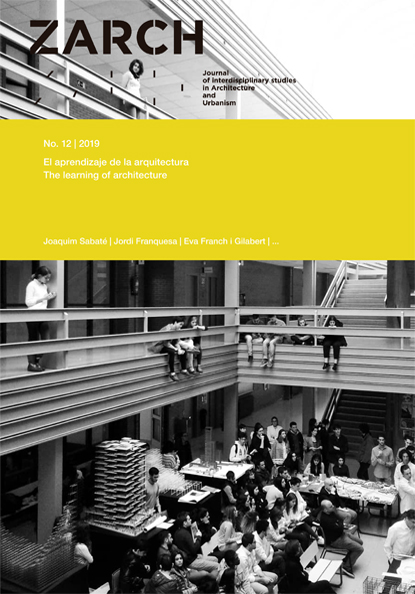Tear Down and Knolling. Strategies for learning the Architectural Design
DOI:
https://doi.org/10.26754/ojs_zarch/zarch.2019123550Keywords:
Organization, Architectural strategies, Tools, Tear Down & knolling, Learning, Design processAbstract
Tear down and knolling are two social networks movements. Both allow visualizing the structure of objects or sets of things that through separation, classification and reorganization of the parts that constitute them give rise to new realities that are different from those that originated them. These movements could be organizational techniques used as design strategies. In this sense, some architects have recognized how organization is part of their work processes, especially in a context where the abundance of information and available material requires designing from what already exists. Therefore, both techniques are analyzed to be used as pedagogical tools, not only as instruments of visual representation brought from the world of the technical object, but also as design strategies applied to teaching. The methodology generated develops fragmented and systematic thinking and allows students to learn to work with complexity. In addition, the resulting architectures tend to be open systems that respond to the conditions of adaptability and flexibility that contemporaneity requires.
Downloads
References
AAVV. 2015. Organization or Design?, Vitoria: Solid Series, A+T Architecture Publishers,
AAVV. 2015. Design Techniques, Vitoria: Solid Series, A+T Architecture Publishers.
AAVV. 2013. In pursuit of Architecture, Log, no. 29.
Ábalos, Iñaqui. 2015. On Design Techniques, AA.VV. Design Techniques, Solid Series. Vitoria: A+T Architecture Publishers.
Bauman, Zygmunt. 2007. Los retos de la educación en la modernidad líquida. Barcelona: Editorial Gedisa,
Galan, Walter et al. (s.f.) “How to créate a Tear-Down”. https://es.ifixit.com/Teardown/How+to+Create+a+Teardown/791 (Consultado el 3 de abril de 2018)
García-Setién, Diego. 2015. “Trans-Arquitectura. Imaginación, invención e individuación del objeto técnico arquitectónico. Transferencia tecnológica desde la industria del transporte al proyecto arquitectónico.” Tesis Doctoral, Universidad Politécnica de Madrid.
Gausa, Manuel; Guallart, Vicente; Müller, Willy; Soriano, Federico; Morales, José; Porras, Fernando. 2001. Diccionario Metápolis Arquitectura Avanzada, Barcelona: Actar.
Gueers, Kersten. 2015. False Friends, AA.VV. Design Techniques, Solid Series. Vitoria: A+T Architecture Publishers.
Kuo, Jeannette. 2015. Constructing Logics, AA.VV. Design Techniques, Solid Series. Vitoria: A+T Architecture Publishers.
Ibañez, Mariana. 2015. Organization or Design? AA.VV. Organization or Design?, Solid Series. Vitoria: A+T Architecture Publishers.
Idemburg, Florian. 2015. To Be Determined, AA.VV. Design Techniques, Solid Series. Vitoria: A+T Architecture Publishers.
“Knolling: Contenido visual para estrategias de aprendizaje”. Blog: Estrategia del contenido https://www.estrategiadelcontenido.com/post.php?pag=knolling_contenido_visual_para_estrategias_aprendizaje (consultado el 10 de enero de 2014)
Langarita, María y Navarro, Víctor. 2015. Bust and Pelt. AA.VV. Design Techniques, Solid Series. Vitoria: A+T Architecture Publishers.
McLellan, Todd. 2013. Things Come Apart. London: Thames & Hudson Ltd.
Munari, Bruno. 1989. ¿Cómo nacen los objetos? Barcelona: Gustavo Gili.
Radcliffe, Austin. 2016. Things Organized Neatly, Nueva York: Universe Publishing.
Rahm, Philippe. 2015. Spectrum, Background and Gradation as Design Techniques, AA.VV. Design Techniques, Solid Series. Vitoria: A+T Architecture Publishers.
Serrano, María Teresa Esquivias. 2004. Creatividad: definiciones, antecedentes y aportaciones. Revista digital universitaria (enero): 1-17.
Torrijos, Pedro. “Knolling: la belleza de organizar y fotografiar objetos que tienes por casa” Blog: Yorokobu. https://www.yorokobu.es/knolling/ (consultado el 25 de octubre de 2014)
Tufte, Edward R. 1990. Envisioning information. Cheshire, Connecticut: Graphic Press.
Velasco, Juan y Velasco, Samuel. 2016. Look Inside. Cutaway illustrations and visual storytelling. Berlín: Gestalten.
Walker, Enrique. 2016. “Una conversación con Kersten Geers y David Van Severen”. Croquis, no 185: 6-19.
Wehrli, Ursus. 2013. The art of Clean Up, San Francisco: Chroniclebooks.


